Review and photos by Faelrin, edited by Suspsy
Yutyrannus is both one of my favorite theropods and favorite dinosaurs in general these days. I still remember coming across an online news article about it back in early 2012 and being excited to see that they finally found a large feathered dinosaur. I’ve been enticed with it ever since. So it was to my pleasant surprise when David Silva had picked Yutyrannus as one of the species to make for the Beasts of the Mesozoic series, and it was among the ones I wanted the most. When the Tyrannosaur Kickstarter launched in September of 2021, it was the third stretch goal and thankfully, it was successfully funded before the campaign ended, as were all the remaining stretch goals. It was by far and large the most successful of the three BotM Kickstarters, surpassing both the previous Ceratopsian and Raptor Series. After a bit of a wait, the Yutyrannus shipped out just this past March. It was one of three figures I was able to pledge for during the Kickstarter, the other two being the Exclusive 1/35 Tyrannosaurus, which I reviewed previously, and the Guanlong. Before going in depth on the figure itself, first I have some background on Yutyrannus.
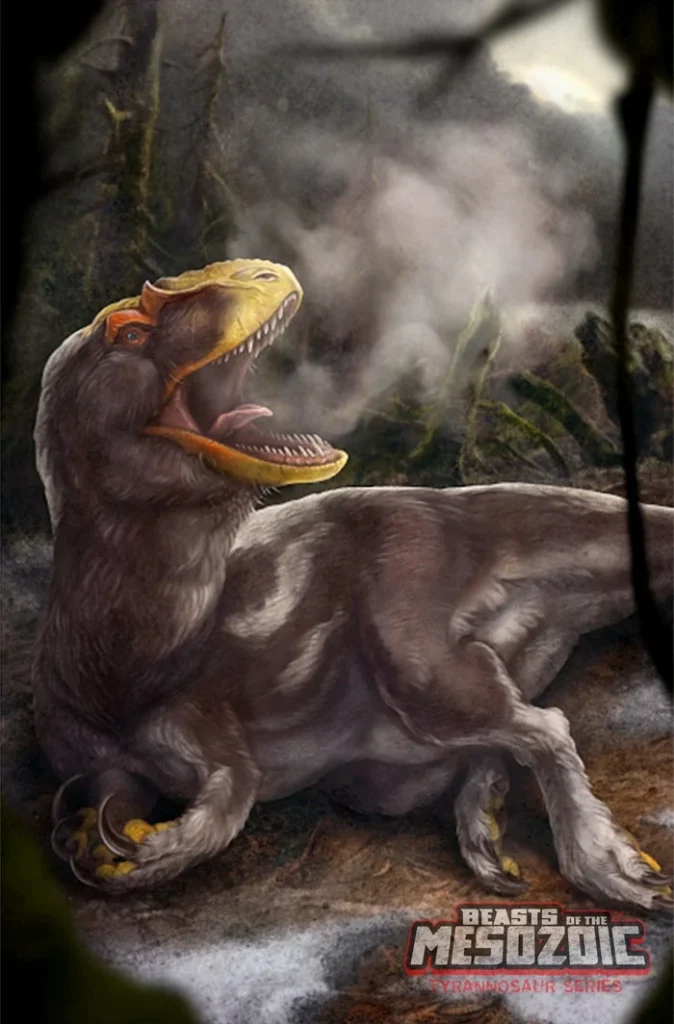
The genus name Yutyrannus comes from the Mandarin Chinese word “yǔ,” meaning feather, and the Latinized Greek “tyrannos,” meaning tyrant. The species name huali comes from the Mandarin Chinese word “huáli,” meaning beautiful. Its name altogether means “beautiful feathered tyrant,” and it sure would have lived up to that if the beautifully preserved fossilized specimens are anything to go by. Yutyrannus is unique among other theropods in that it is rare for numerous individuals of varying life stages to be preserved, and with such remarkable near-completion at that. The holotype specimen ZCDM V5000 is the largest one. Paratype ZCDM V5001 is a smaller specimen and ELDM V1001 is a juvenile, which gives us a good look over much of Yutyrannus‘ lifespan. Filaments were found on all three specimens: on the tail in ZCDM V5000, near the pelvis and foot in ZCDM V5001, and on the arm and neck on ELDM V1001. This shows that nearly the entire animal was covered in feathers. Another interesting feature, aside from the filaments that helped give Yutyrannus its name, was the crest on its skull, not too dissimilar to its relative Guanlong. It lived during the Early Cretaceous (125 Ma) in Yixian Formation of Liaoning Province, China. It probably lived alongside dinosaurs like Beipiaosaurus, Caudipteryx, Dilong, Psittacosaurus, Sinosauropteryx, Zhenyuanlong, and many other animals also from within the Yixian Formation, although the exact locality of where the Yutyrannus fossils were found is unknown. The environment would have been a cool temperate rainforest with wet, humid, and dry arid seasons. Flora included conifers, ferns, flowering plants, ginkgos, horsetails, and cycads. Temperatures have been estimated to be around 10°C/50°F, cooler than many other environments during the Cretaceous.
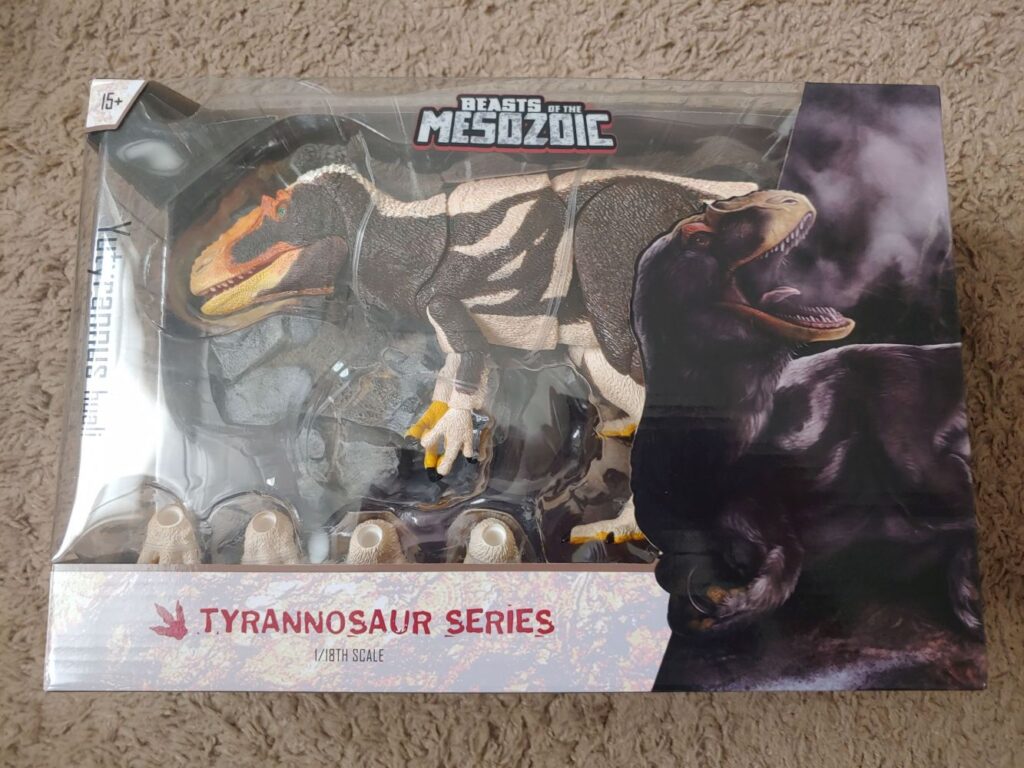
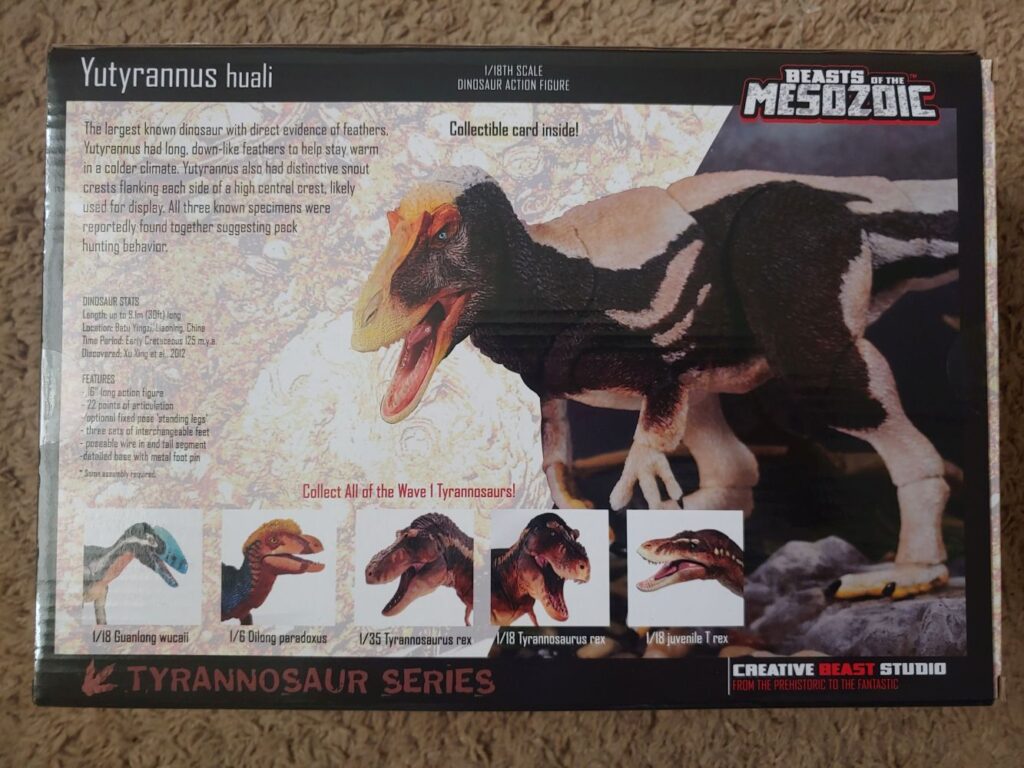
The packaging is a much newer design from the previous BotM series, but it still shares some similarities. On the front is a clear window where most of the figure can be seen and on the side is the package art created by artist Shannon Beaumont. This time, some of the artwork is cut out to make for more room for the window. The back of the packaging features an image of the figure, some information about the animal, and images of its wave mates. The sides of the box feature the logo and on the bottom is information crediting who helped work on the figure as well as the package art again. Looking through the window, one can see the contents, including the figure, which has been assembled with the static standing legs by default, a base, the tail which needs to be attached separately, and some alternate feet and the articulated posing legs. The box is nearly one foot/30.48 cm long, about 4.25 inches/10.80 cm wide, and 8 inches/20.32 cm tall.
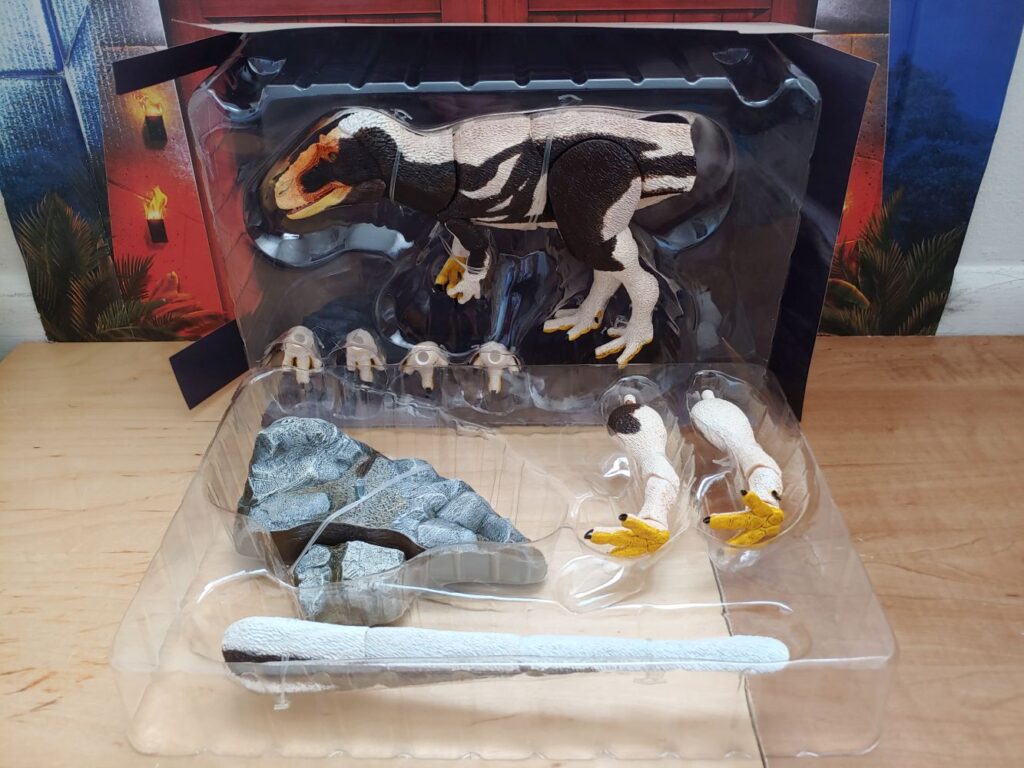
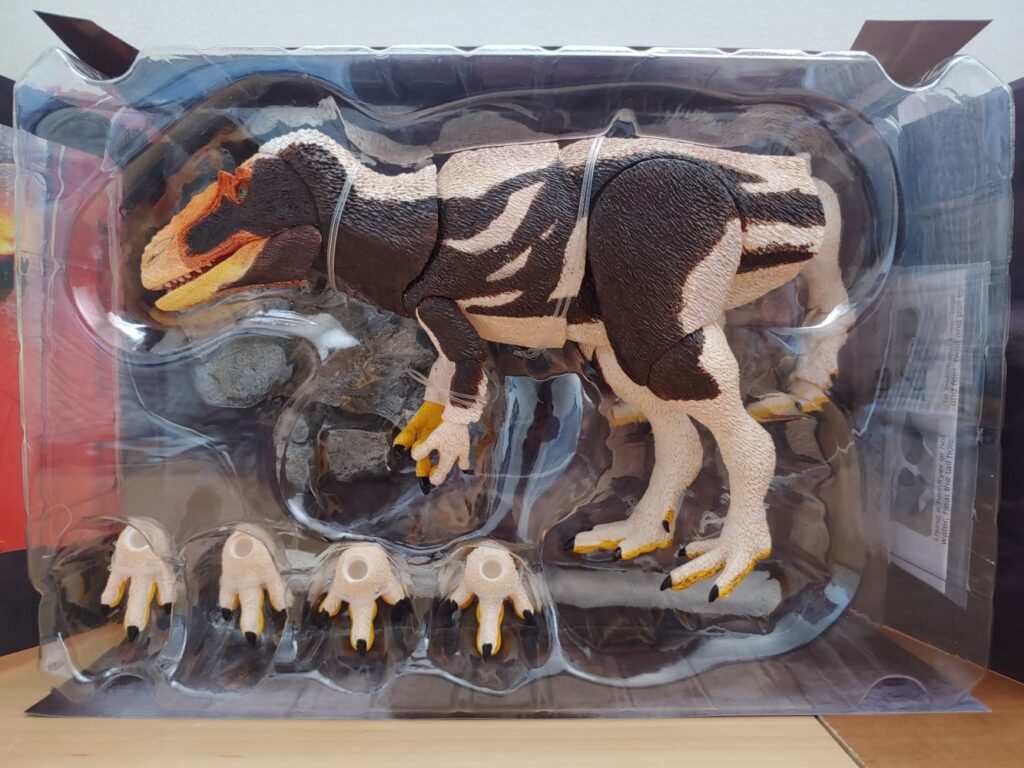
The base on the prototype sculpt appeared to have been painted to look like it was covered in a dusting of snow, but it looks to have been revised since, as the final base has light grey stones with a brown moss or dirt type of texture in between the stones. The base is about 7 inches/17.78 cm long by 4 inches/10.16 cm wide, or over 5 inches/12.7 cm with the extended clipped section on it and about 1.25 inches/3.18 cm tall. The underside of the base is hollow and there is a single steel peg on it to be used with the static standing legs.
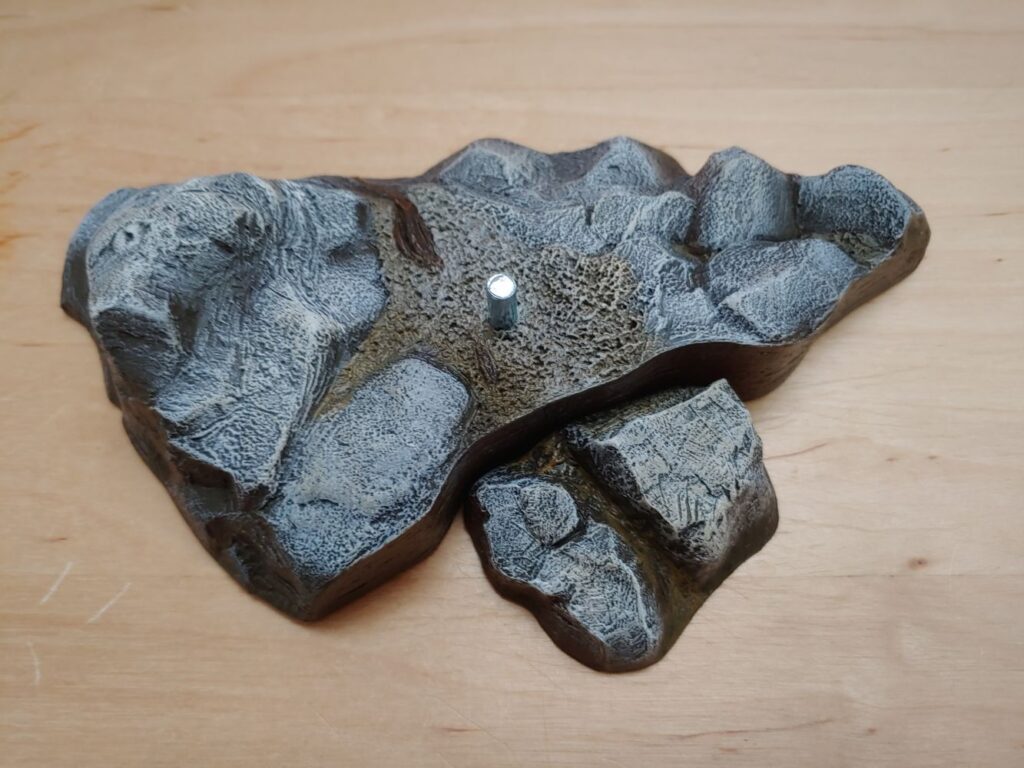
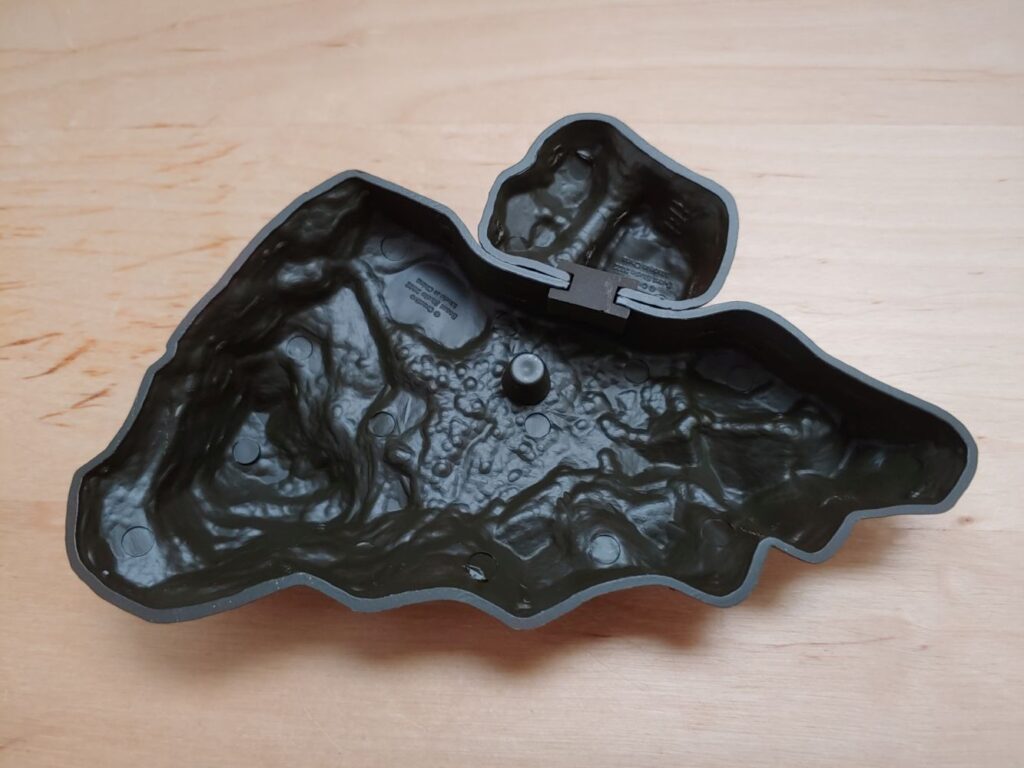
It is worth mentioning the collector card included is unfortunately of a lower resolution than intended, looking rather pixelated. David has been sending out replacement cards that are the proper higher quality, so be sure to send him a message if you ordered this figure, and would like one. I’ve included images of both cards to compare the differences.
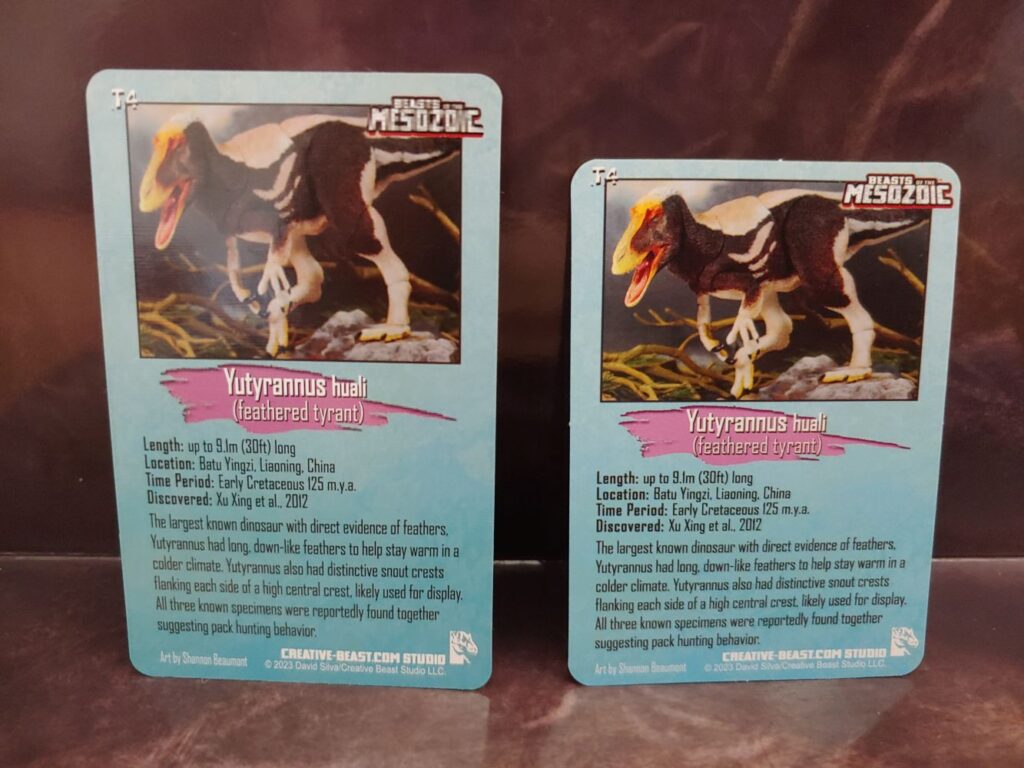
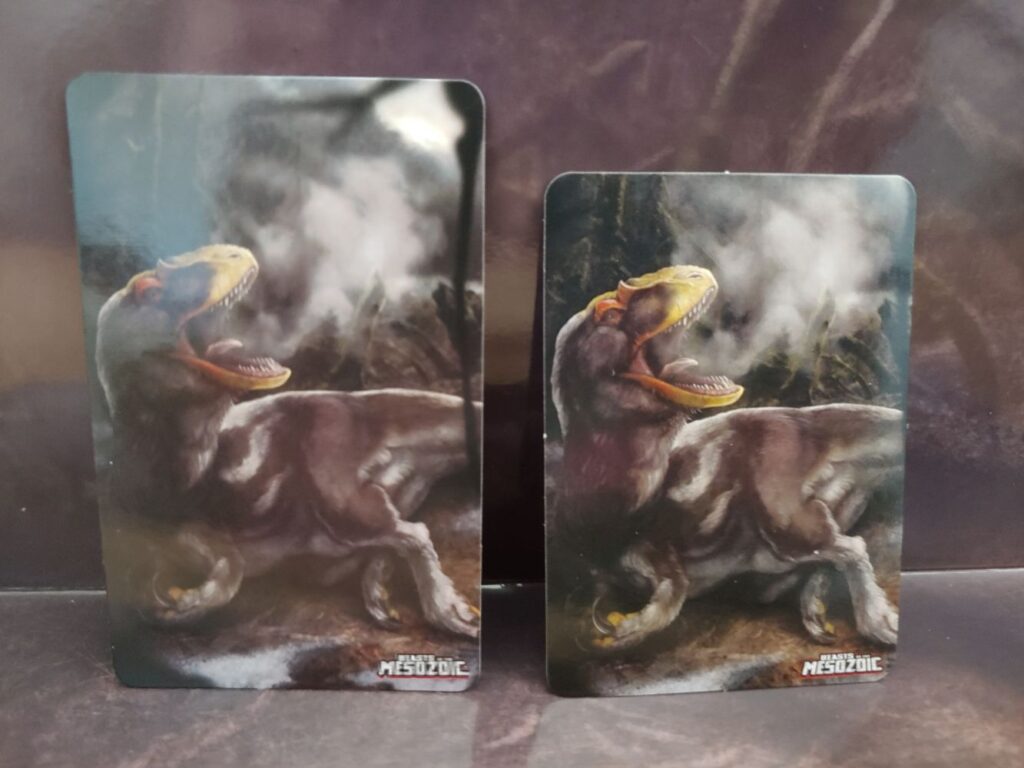
Now to finally focus on the figure itself. For starters, the color scheme was based upon the Steller’s sea eagle (Haliaeetus pelagicus). It is translated rather beautifully on the figure, although there is a bit of divergence with the pattern and markings to accommodate the lack of a beak and wings and the presence of a longer tail. Like the eagle, the head, the palms of the hands, and the feet are yellow while the plumage is a mix of brown, tan, and white. There is also a bit of an orange applied to the crest and face around the feathery brown bits, and the eyes are blue-green. The sculpt was initially created digitally by Jake Baardse, Raul Ramos managed the articulation and 3D print, and David Silva intricately sculpted the feathering afterwards.
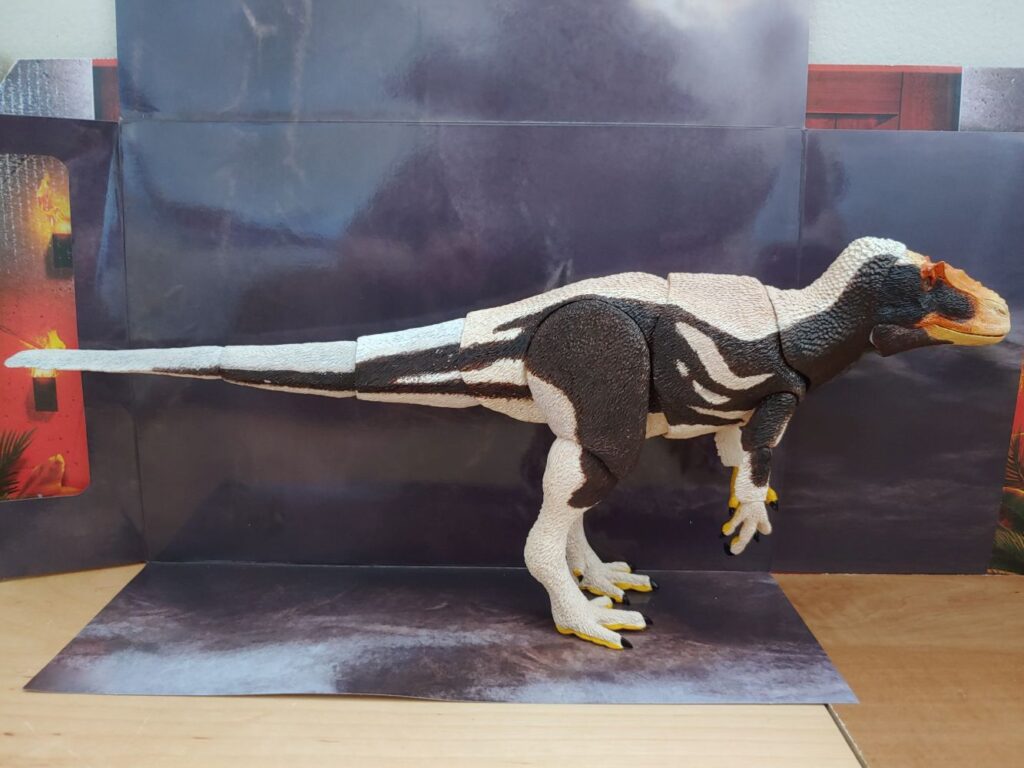
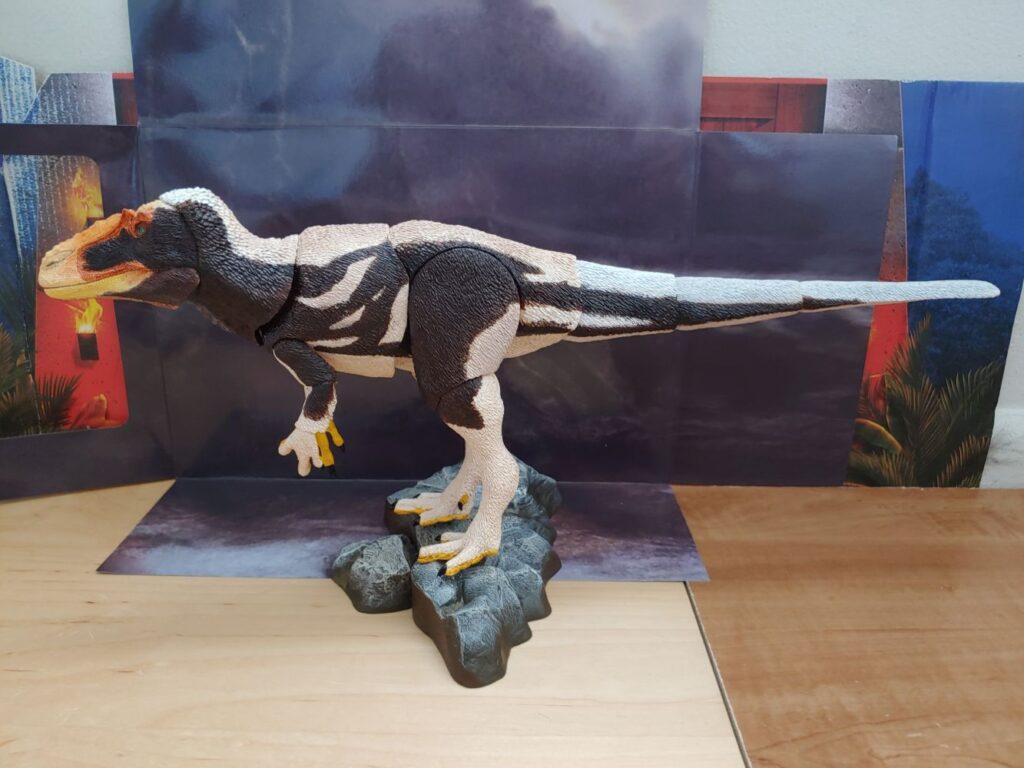
The Yutyrannus is about 16 inches/40.64 cm long from the tip of the snout to the end of the tail when in a neutral standing pose, about 5.5 inches/13.97 cm tall at the hips, and about 6 inches/15.24 cm or so at the top of the neck section. The skull is about 2.5 inches/6.35 cm long, or 3 inches/7.62 cm including the back of the neck. The ZCDM V5000 specimen was given an estimated skull measurement of 905 mm, or 90.5 cm/35.6 inches, which would put this figure around the 1:14 scale, give or take. Using the larger estimate of 29.5 feet/9 meters long, it would put this figure at about 1:22 scale, but using the smaller estimate at 24.6 feet/7.5 meters long, it would have an estimated scale of around the intended 1:18 scale. Take these scale estimates with a grain of salt, as I did them with an online calculator. If anything is incorrect, please leave a comment.


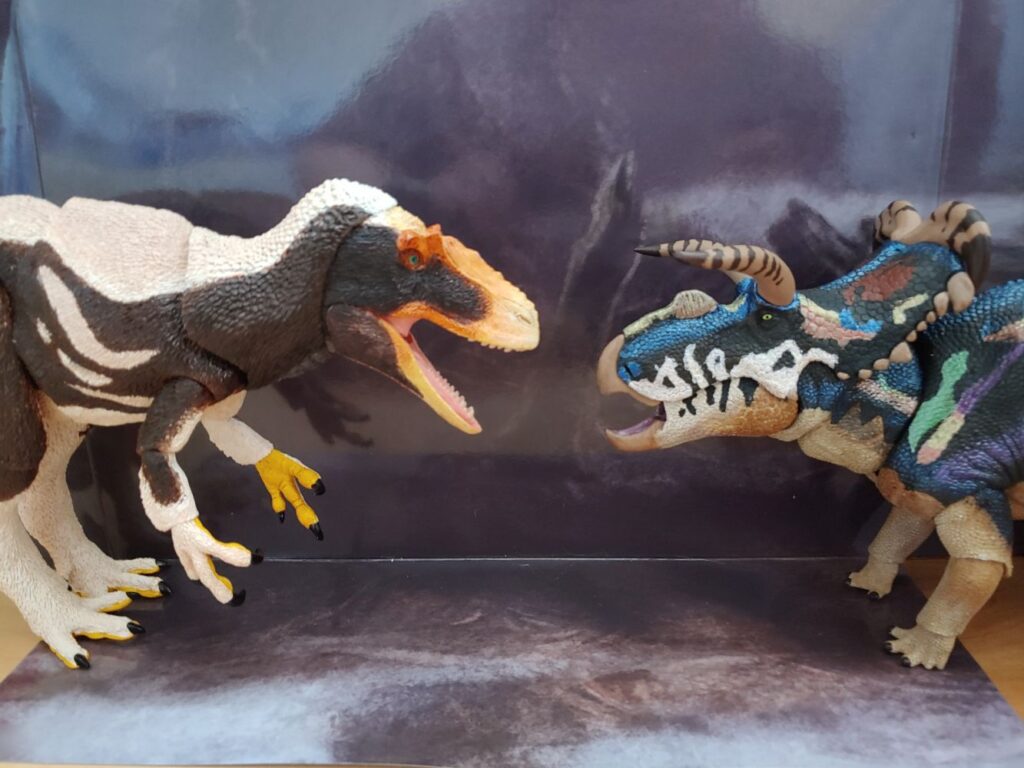
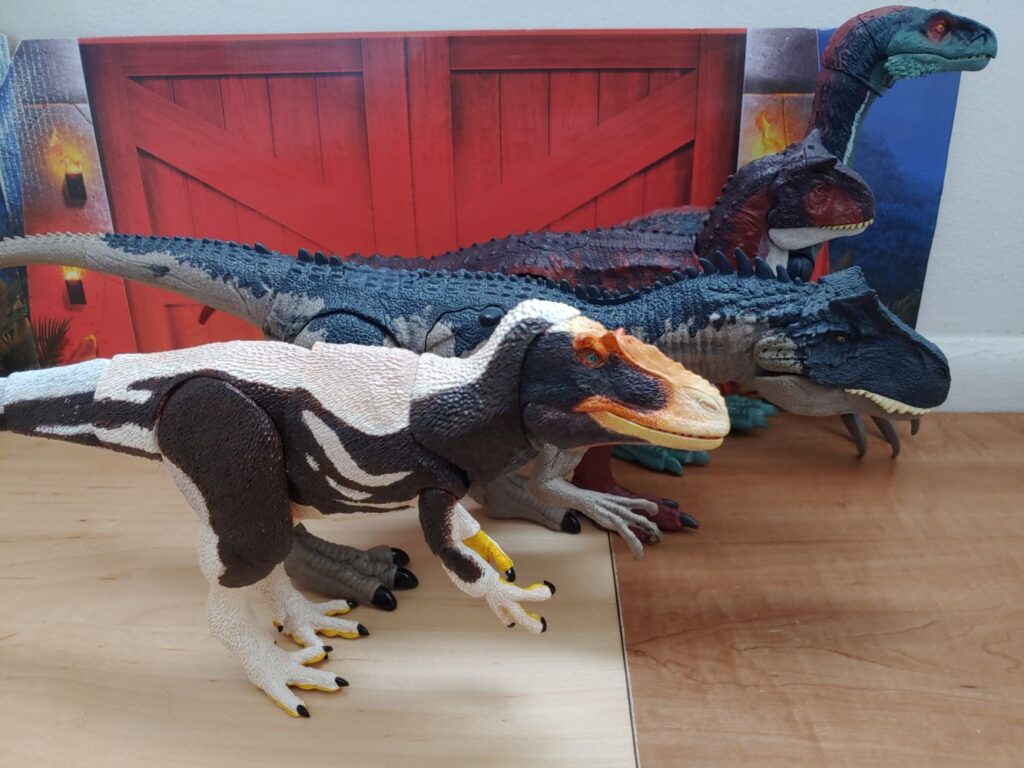

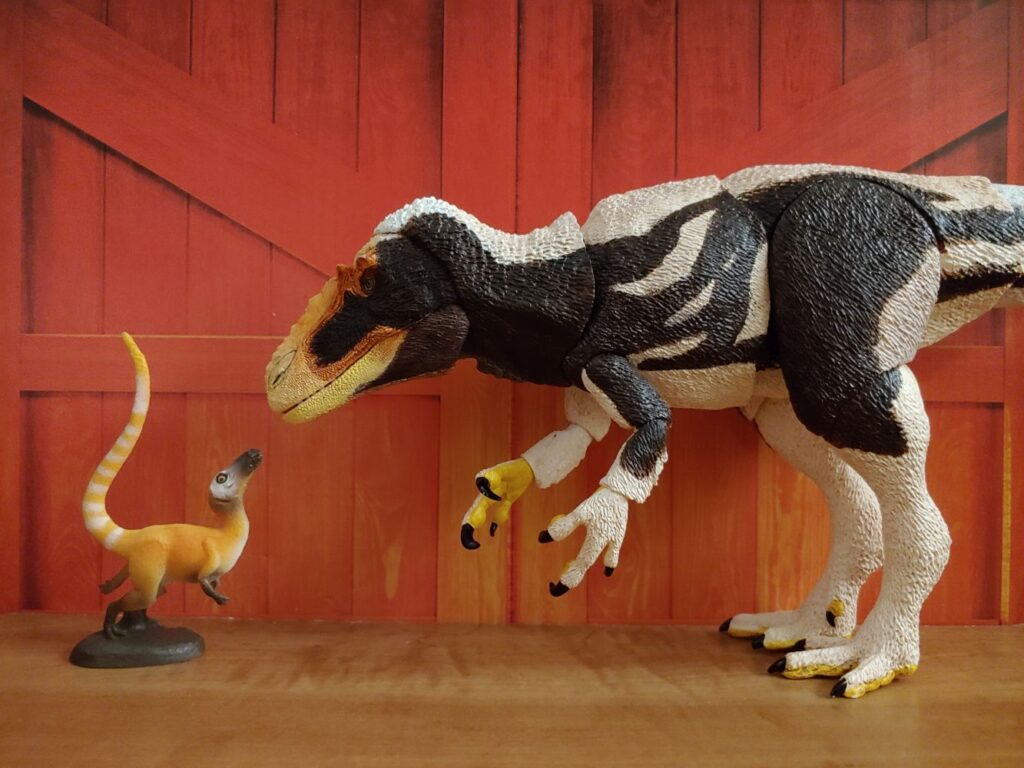
Anyways, like the other non-avian theropods in the BotM series so far, this figure has been given lips on its mouth. The sculpt adheres to the fossil evidence on the animal, from the long shaggy coat of filaments to the shape of the skull and crest and to the large, powerful, three-clawed fingered hands. The only speculative bits are, as far as I can tell, the inclusion of lips, the coloration, and the scales and fleshy pads on the hands, the feet, and the face, which I saw no mention of being preserved in the formal description. Another theropod called Anchiornis, on the other hand, has been beautifully preserved showing those features, which were revealed after studying the specimen under laser-stimulated fluorescence (or LSF), in a paper by Xiaoli Wang, et al, in 2017. The LSF showed there were fleshy, bird-like pads on the feet, covered in reticulae, so perhaps it was possible that Yutyrannus had something similar as well. There has also been similar integument with fleshy pads found in a dromaeosaurid called Microraptor, at least on the feet, as well as several other theropods when looked at under LSF (Michael Pittman, et al, 2022). The tail tip also has a slight fan shape to it, and while I saw no mention of a fan shape in the paper, Yutyrannus‘ relative Dilong does. I do not know if Yutyrannus has preserved melanosomes that can indicate any coloration, as the paper did not mention that either, but several published studies on other non-avian theropods including Anchiornis, Microraptor, and Sinosauropteryx have found melanosomes within their integument, allowing their coloration to be inferred. Hopefully we’ll have the luck of getting an idea of what colors this particular animal sported someday.

In the midst of writing this review, a new paper by Thomas Cullen, et al, was released which showed that lips are the most likely plausible conclusion for non-avian theropods at this time. In the paper, they provide evidence to counter numerous points that have been raised in the past, such as theropod teeth being too big to be covered with tissues. For starters, they compared the placement of foramina (the little dots on the skulls which serve as attachment points for blood vessels and nerves) of non-avian theropod skulls, extant lepidosaurs, extant crocodilians, and extinct terrestrial crocodylomorphs. Extant crocodilians have different foramina placement when compared to the lepidosaurs, non-avian theropods, and the extinct terrestrial crocodylomorphs. These serve as attachment points for their sensory organs and are adaptations likely due to their semi-aquatic lifestyle. The paper also compared the thin enamel of theropod teeth (such as from Daspletosaurus), and the thicker enamel of Alligator mississippiensis under a microscope. The Daspletosaurus tooth had enamel that was relatively intact, showing evidence that it was kept hydrated, which is crucial to keep enamel strong, whereas the enamel and dentine of the alligator tooth had been worn away in the areas where it was exposed to the elements. Furthermore, extant crocodilian teeth lean outwards, whereas non-avian theropod teeth, and those in lepidosaurs are vertically aligned. Additionally, they compared tooth height to skull length of various non-avian theropods (see the supplementary material included with the paper), and extant monitor lizards in the genus Varanus, which notably all have lips. The data showed that theropod teeth would not have been too large to have been covered with lips or other tissues when the mouth was closed, especially when compared with some extant Varanus species. It is definitely worth a full read, and I would also recommend reading the breakdown by Mark Witton, who contributed to the paper as well.

Getting back to the Yutyrannus figure, as far as the articulation goes, the neck can move a little bit up and down and side to side; a bit limited like the 1/35 T. rex I previously reviewed, although the torso section can help to move it a tad bit more up and down. The lower jaw can open quite a bit, and the articulation at the joint feels pretty solid. Worth noting that my figure had a warped bottom jaw/lip and couldn’t close properly until after I gave it a heat treatment. More on that later. The arms have articulation at the shoulders, elbows, and wrists. The elbows can move outwards and inwards a bit, and can be rotated nearly 360 degrees. They also have a bit of up and down movement, only limited by the plumage where the two joints meet. The hands can be moved up and down a little bit, rotated 360 degrees, and folded inwards and outwards a little bit as well. The hip joints can be moved back quite a bit, but not much forward, and can be moved outwards and inwards a little bit as well. Like many of the other figures in the Tyrannosaur Series, this figure comes with a pair of static legs for long term display and a pair of articulated posing legs to be used for short term displays (such as toy photography). The static legs can move at the knees, but mine are a bit tight, and I haven’t gotten around to giving them a heat treatment yet. Some extra paint might chip out when moving the joints and popping out the legs. The other pair of legs have articulation at the knees as well as the ankles, and there are extra feet for different poses as well. There’s also joints for the toes to be moved up and down and rotated, which is what the extra feet are attached to. I would recommend using some heat treatment to help get them on. Lastly, the tail has three joints, at the base where it is joined to the body, and two more joints further along. The last section has a bendy wire within it to help with posing if so desired. Some of the poses I was able to get this beast into include a hunting running pose, a resting pose, and the squatting pose that the PNSO Yutyrannus figure is in.
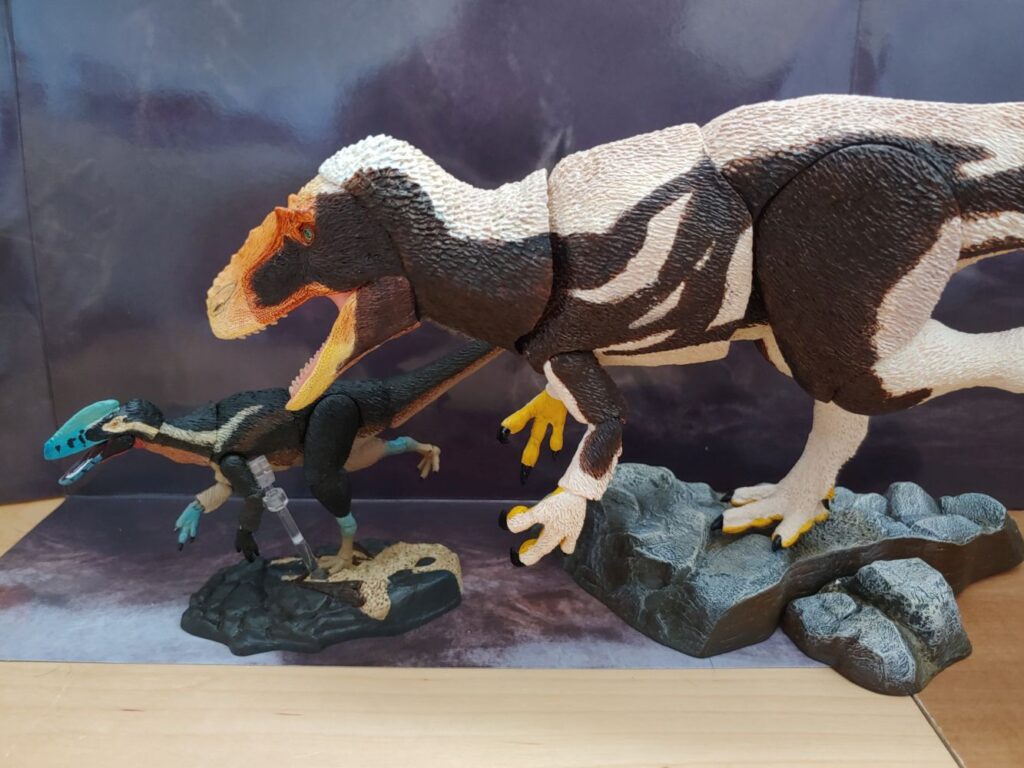

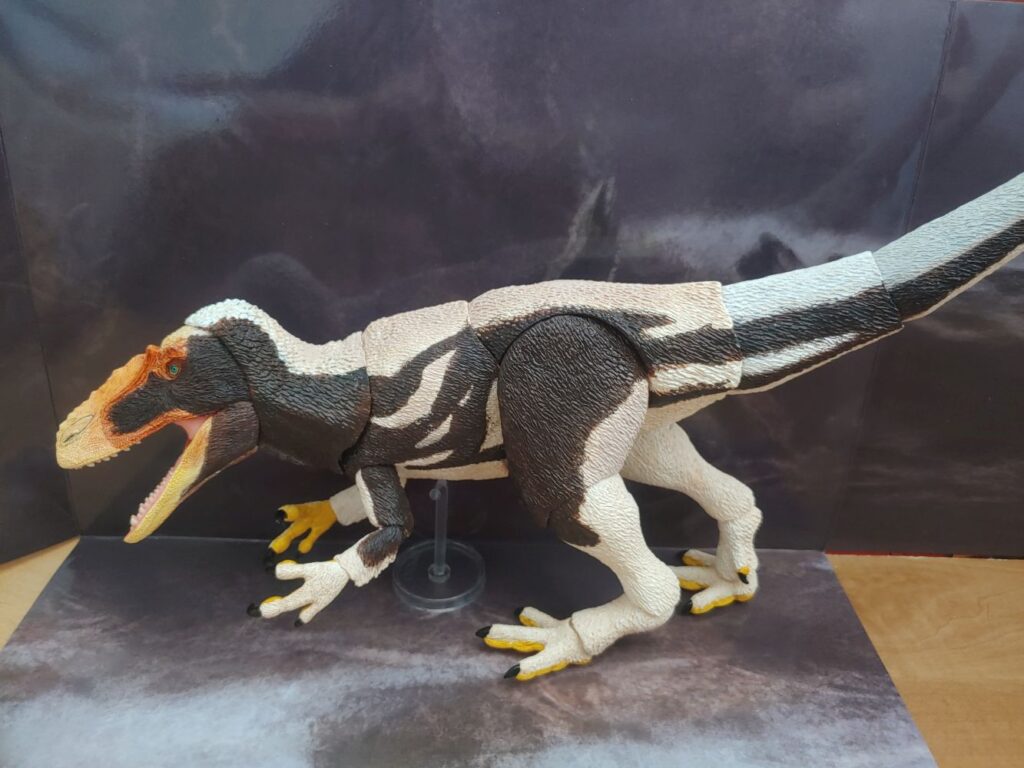
As mentioned before, the jaw on my figure was warped, but after a heat treatment by way of microwaving some water in a cup to a scalding temperature and then dipping and holding the figure’s head in for a minute, I fixed up the position of the lower jaw’s lips and tied the jaws tightly with a rubber band. Afterwards, I ran it under cold water and let it sit for about ten minutes. It’s still a tiny bit lopsided on the right side, possibly because I didn’t let it sit for a longer period of time, and had already gone about opening and closing the jaw to get images for this review. Aside from the limited neck movement (although I do find it a bit better then on the 1/35 T. rex), and this warped jaw issue, I don’t really have much that got in the way of my enjoyment of this figure. Another minor drawback is that the figure can’t be put into any satisfactory sitting poses like the raptors or ceratopsians due to the limitations on the hip and other leg joints. Closest you can get is a squatting or crouching posture.

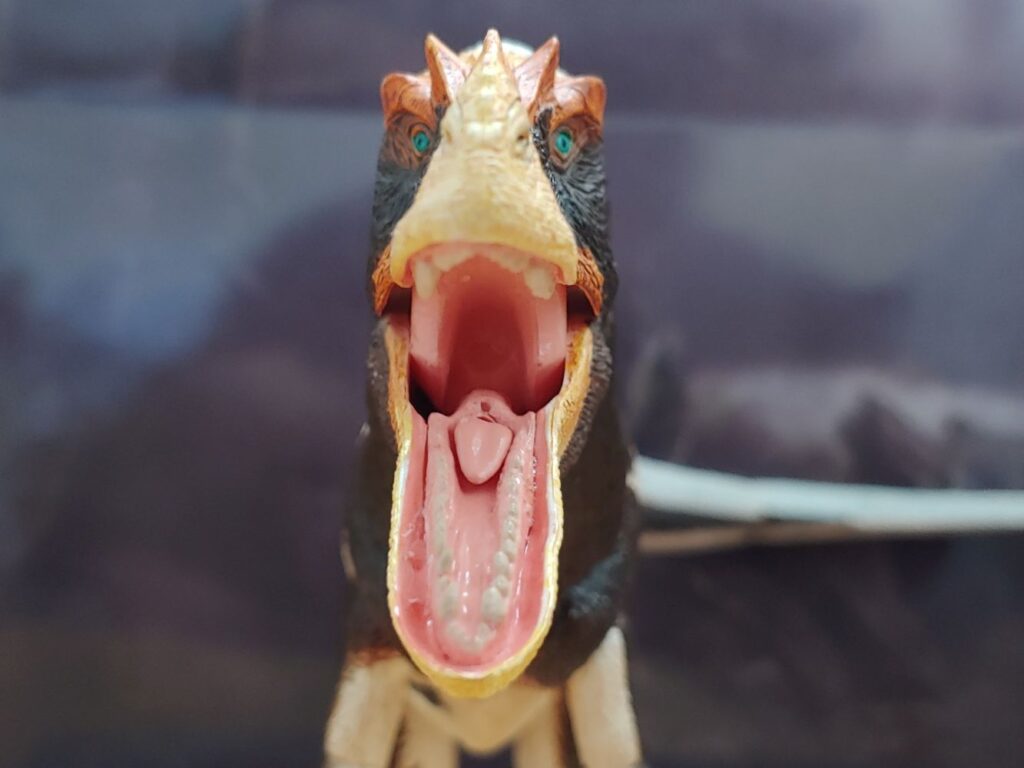
Otherwise, I’m pretty satisfied with it, and I think it might be my favorite of the line so far, as far as the articulation, sculpt, and coloration go–although some future contenders like the Wave 3 Gorgosaurus might challenge that. Since these just recently shipped to us Kickstarter backers, I imagine they should now be in supply for anyone else that wants one, such as at Creative Beast’s website itself, Big Bad Toy Store, Everything Dinosaur, and Minizoo, if not very soon. As mentioned earlier in the breakdown on Yutyrannus anatomy and environment, it is also worth mentioning that Dilong, Psittacosaurus, and Zhenyuanlong have also received Beasts of the Mesozoic figures in 1/6 scale, and in the case of Psittacosaurus, also in 1/18 scale. I hope the Dilong and Zhenyuanlong can receive the 1/18 scale treatment some day, as they would display nicely alongside this Yutyrannus, since again there is a possibility they might have coexisted with it. The PNSO Little Dinosaurs Sinosauropteryx might also be of interest, and might size up nicely alongside this figure. A little reminder that David Silva’s next Kickstarter project, the Cyberzoic series, is coming this October 3rd. Plenty of genera of interest are going to be included in it, such as Allosaurus, Carnotaurus, Dilophosaurus, Stegosaurus, Smilodon, and Utahraptor, as well as dragons. Also, lastly a little fun fact: while working on this review, a new DLC for Jurassic World Evolution 2 was just released featuring Yutyrannus (as well as Sinosauropteryx, mentioned a few times throughout this review). By far my favorite media appearance of it so far, aside from its prior appearance in Ark: Survival Evolved (in which the Cyberzoic Carnotaurus will make a nice display mate as a homage to that game).
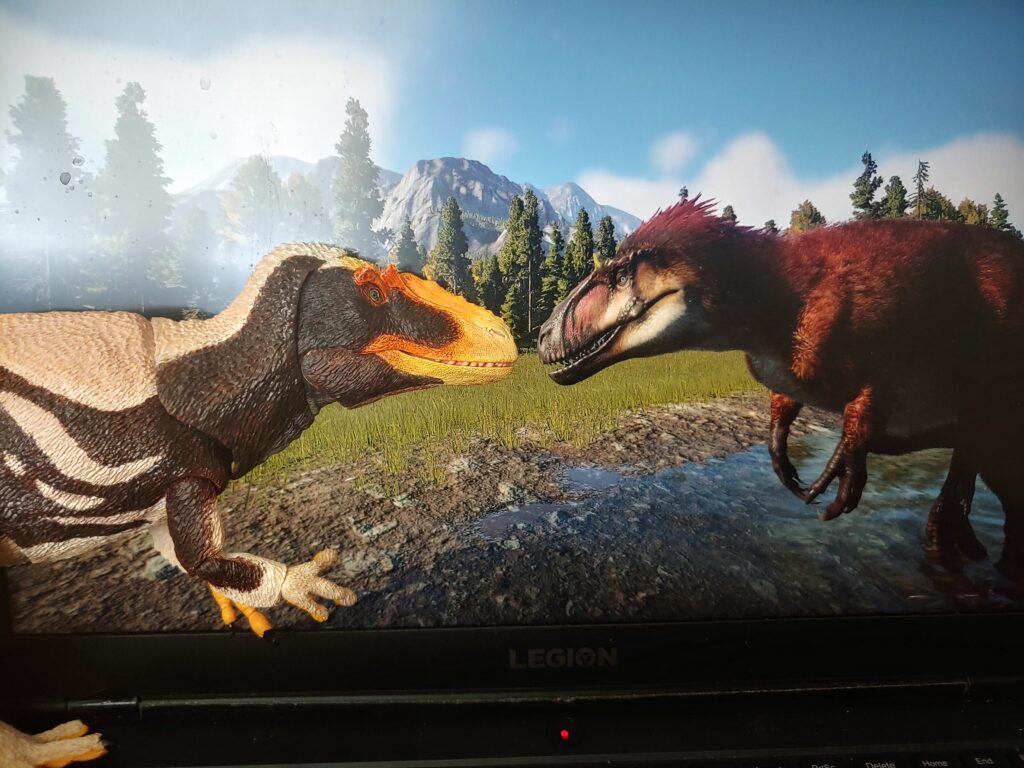
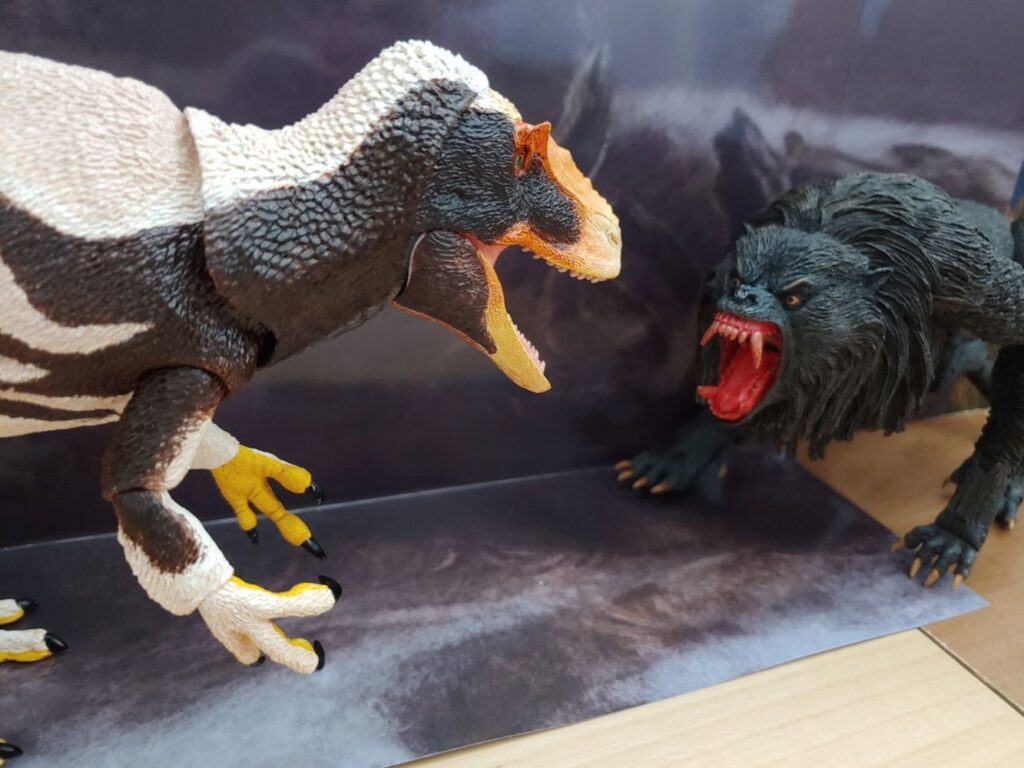
Support the Dinosaur Toy Blog by making dino-purchases through these links to Ebay and Amazon. Disclaimer: links to Ebay.com and Amazon.com on the The Dinosaur Toy Blog are often affiliate links, when you make purchases through these links we may make a commission

Maybe it’s just me but…
The final picture of Yutyrannus and the werewolf=Partridge Creek Monster staring down a Waheela.
I like the sculpt and size of the figure. Not a big fan of the chocolate and cream’ colour scheme, so I may wait for a repaint of this one or repaint myself.
J’aime beaucoup ce model car c´est la première fois qu’il y a une marque de figurine qui fait un si grand yutyrannus
Et pour les lèvres un paléontologue français à dit qu’ il y a pas assez de prevre pour les lèvre car dans cette publication il a découpé une seule dents pourtant il y a énormément de dent de tyrannosauroïde donc ces article montre juste que les dent de dinosaures théropodes n’était pas Trop longue pour possédé des lèvres